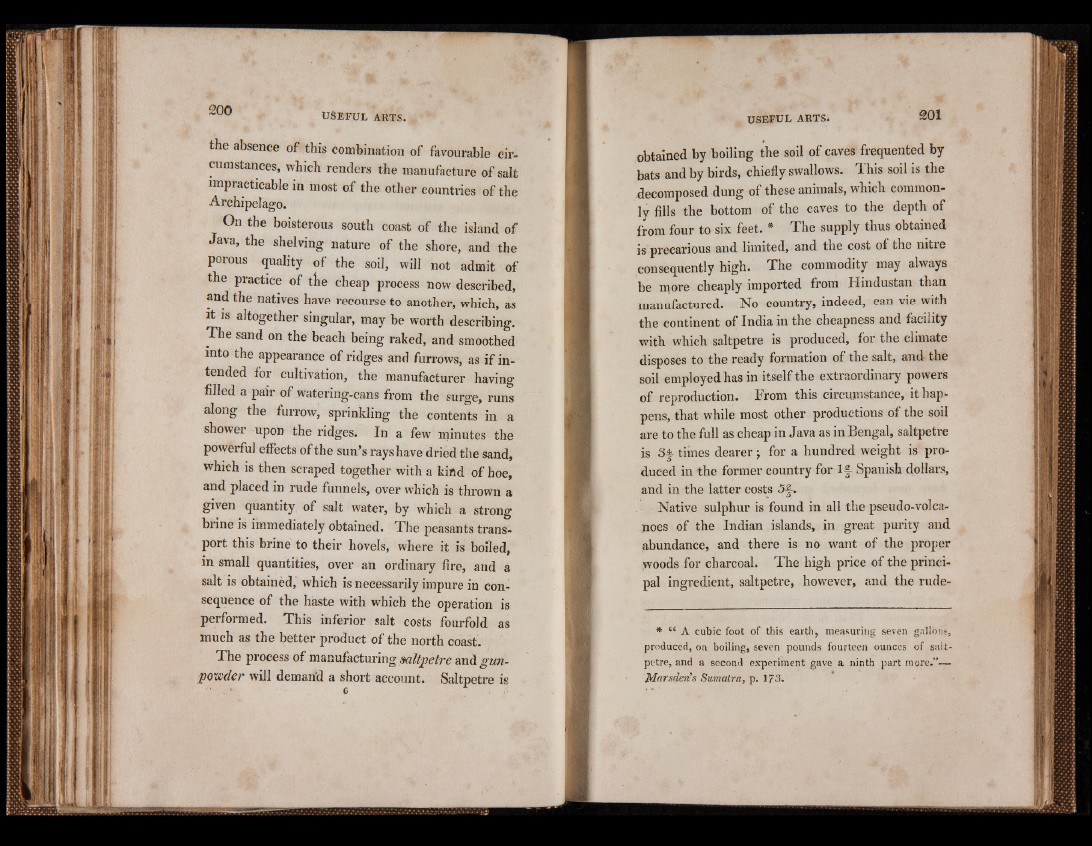
the absence of this combination of favourable circumstances,
which renders the manufacture of salt
impracticable in most of the other countries of the
Archipelago.
On the boisterous south coast of the island of
Java, the shelving nature of the shore, and the
porous quality of the soil, will not admit of
the practice of tke cheap process now described,
and the natives have recourse to another, which, as
it is altogether singular, may be worth describing.
The sand on the beach being raked, and smoothed
into the appearance of ridges and furrows, as if intended
for cultivation, the manufacturer having
filled a pair of watering-cans from the surge, runs
along the furrow, sprinkling the contents in a
shower upon the ridges. In a few minutes the
powerful effects of the sun’s rays have dried the sand,
which is then scraped together with a kind of hoe,
and placed in rude funnels, over which is thrown a
given quantity of salt water, by which a strong
brine is immediately obtained. The peasants transport
this brine to their hovels, where it is boiled,
in small quantities, over an ordinary fire, and a
salt is obtained, which is necessarily impure in consequence
of the haste with which the operation is
performed. This inferior salt costs fourfold as
much as the better product of the north coast.
The process of manufacturing saltpetre and gunpowder
will demand a short account. Saltpetre is
■' . •• 6
obtained by boiling the soil of caves frequented by
bats and by birds, chiefly swallows. Ihis soil is the
decomposed dung of these animals, which commonly
fills the bottom of the caves to the depth of
from four to six feet. * The supply thus obtained
is precarious and limited, and the cost of the nitre
consequently high. The commodity may always
be more cheaply imported from Hindustan than
manufactured. No country, indeed, can vie with
the continent of India in the cheapness and facility
with which saltpetre is produced, for the climate
disposes to the ready formation of the salt, and the
soil employed has in itself the extraordinary powers
of reproduction. From this circumstance, it happens,
that while most other productions of the soil
are to the full as cheap in Java as in Bengal, saltpetre
is 8 f times dearer; for a hundred weight is produced
in the former country for I f Spanish dollars,
and in the latter costs 5 f.
Native sulphur is found in all the pseudo-volcanoes
of the Indian islands, in great purity and
abundance, and there is no want of the proper
woods for charcoal. The high price of the principal
ingredient, saltpetre, however, and the rude*
“ A cubic foot of this earth, measuring seven gallons,
produced, on boiling, seven pounds fourteen ounces of saltpetre,
and a second experiment gave a ninth part more.”—
Marsden's Sumatra, p. 173.